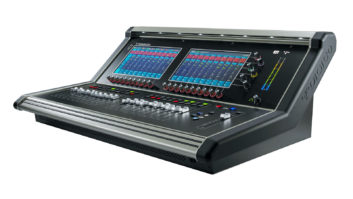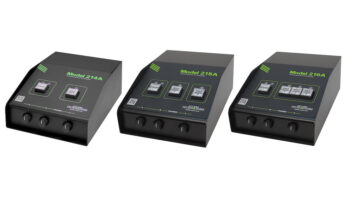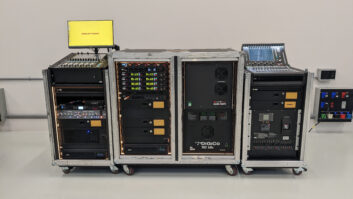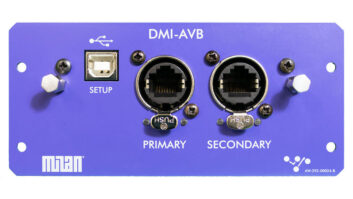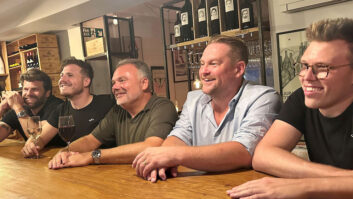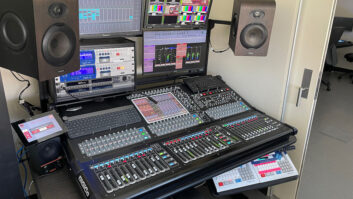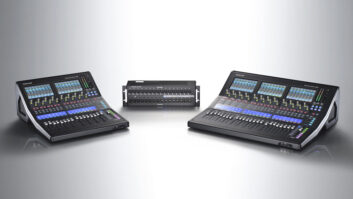
FOH engineer Toby Francis at the DiGiCo SD7
Photo: Carlos Escobar; courtesy of Meyer Sound
DiGiCo reports that veteran front-of-house engineer Toby Francis, whose résumé ranges from Aerosmith to ZZ Top, is currently out on an 88-date tour with pop artist Ariana Grande and a DiGiCo SD7 digital mixing console. “The Honeymoon Tour,” which takes in North America, Europe and Asia before wrapping up in South America at the end of October, also includes an SD7 at the monitor position, helmed by engineer Justin Hoffmann.
Francis, who says he is approaching his eighth year of using DiGiCo consoles almost exclusively, comments, “It’s very, very easy to mix music on this console and it works in a very straightforward manner. It’s got everything you’d ever need onboard. For the last two years I’ve been using a Waves SoundGrid server, but prior to that I didn’t—I just used the console and nothing else.”
Francis says that although he typically favors DiGiCo’s SD10 desk, he switched to the SD7—supplied by VER Tour Sound—for “The Honeymoon Tour” in order to better accommodate the show’s 90-input channel count. “It’s a blend of track and live inputs, with the emphasis on live inputs,” he says, including multiple keyboards, guitar, bass, drums and a small string section. “The only thing that is obviously track is her background vocals. She did all of the backgrounds on the record, so the only way to make it sound right was to continue that.
“It’s pop, so the levels are pretty drastically different from song to song. On a lot of the songs there’s an intro section, then into the regular song, so I use at least one snapshot to set up each song. A couple of the songs have more than one,” he says.
The DiGiCo’s multiband dynamic equalizers and compressors are also essential to his mix, says Francis, who groups drums, bass, keyboards and other instruments separately. “I take all of those groups into yet another group of all the music and create a separate path that’s all of the vocals. I treat the two paths completely separately, then I combine them into the Meyer Sound LEO/LYON P.A. system.
“I use a lot of layers of compression. I use the Waves C6 on Ari’s vocal, then go into a group with the onboard three-band compressor and take her vocal and the background vocals and compress them together there. It sounds so polished. My daughter came to a recent show and I put her in the front row. She was showing me videos she had made and the sound was crystal clear.”
Francis adds that the console’s onboard processing is key to its sound quality. “I use the multiband dynamic EQs everywhere. Instead of doing drastic low-mid cuts I’ll just use compression. The information is still there, it’s just compressed so that it fits better. There’s a lot less contouring and a lot thicker sound. I think that’s why you hear things on the DiGiCo that you don’t hear on some of the other desks. There’s just more there.”

Toby Francis works on Ariana Grande’s mix using one of her tour’s two DiGiCo SD7 consoles.
Photo: Carlos Escobar; courtesy of Meyer Sound
Francis and Hoffmann share one large rack. “We call it our ‘execution rack.’ It has two DiGiCo SD-Racks, a MADI converter and word clock distribution to all of the external digital devices,” Francis elaborates. “It’s also got all of the wireless receivers and ear transmitters, all hardwired. The stage rolls at about two o’clock, the monitor console rolls under the stage and the rack rolls in. The cabling is pre-laid when they build the stage so we’re literally checking things ten minutes after the stage rolls.”
Tracks from two Pro Tools computers pass via Antelope Audio interfaces into a D.O.TEC MADI switcher that selects machine A or B and sends it to an Optocore converter. “That shows up like a stage rack,” explains Francis. “Of everything we tried, that was sonically the best way to do it, and it gave both front-of-house and monitors the most versatility.” The system also enables timecode distribution for the show’s video, lighting and laser automation.
He adds, “We don’t use a splitter, which is a huge sonic advantage. By eliminating a splitter you keep your impedances as pure as possible. By having the SD-Rack at the stage you cut your copper link to 100 feet or less on every input. Then the sonic advantage of the console really itself takes it to a whole new level.”
For more information, visit www.digico.biz and www.verrents.com.

